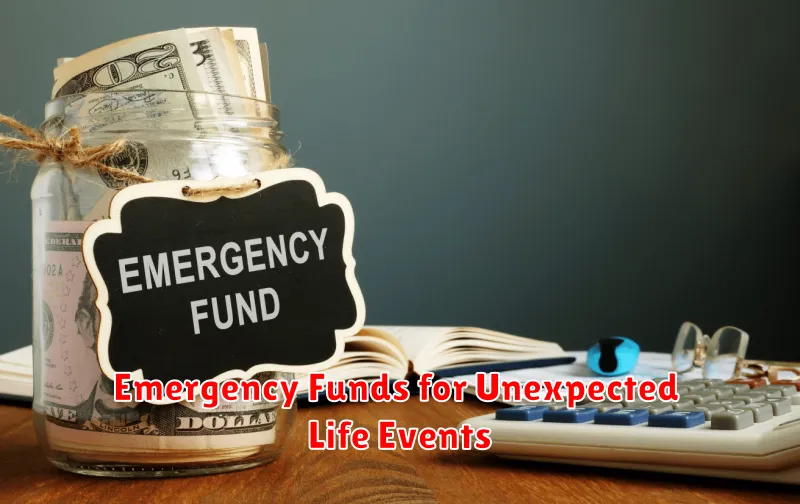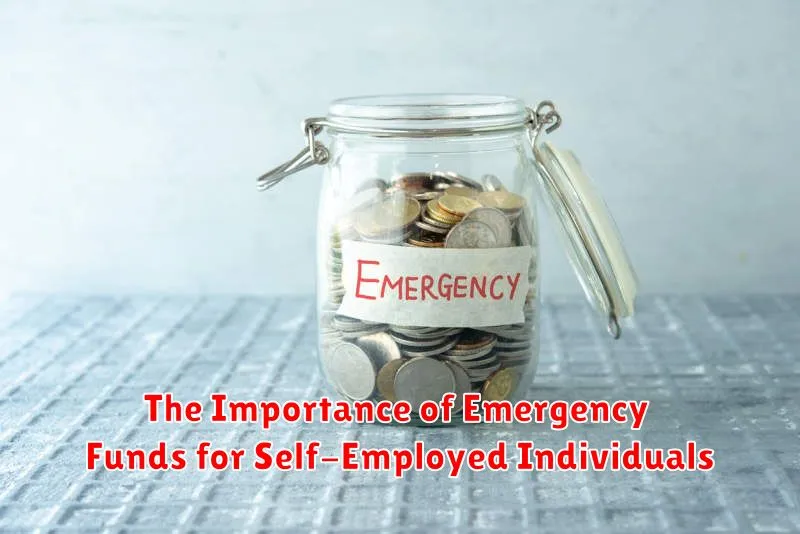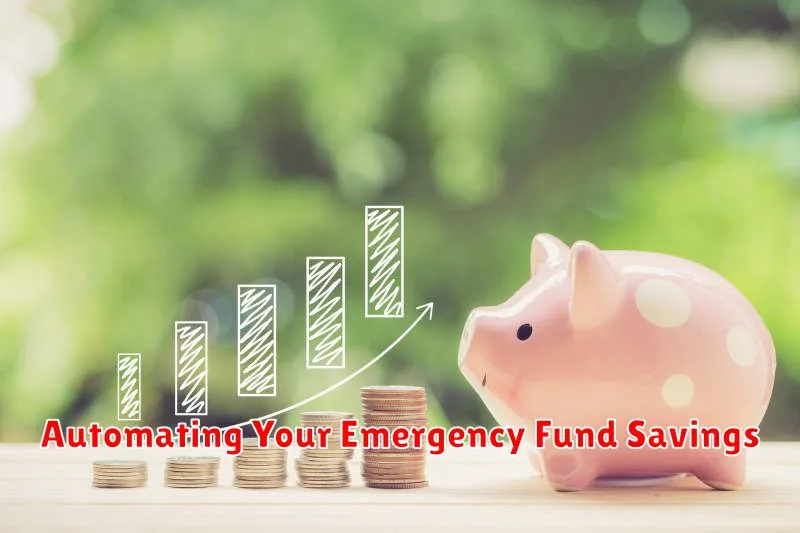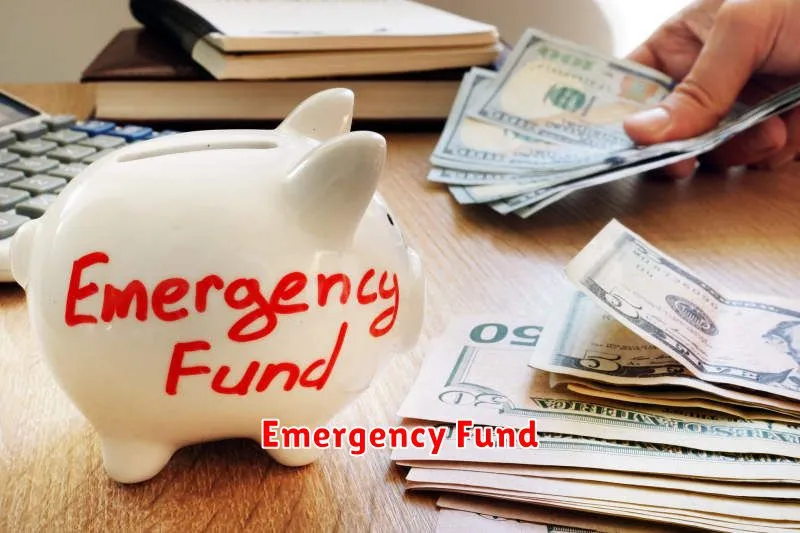Life is full of unexpected expenses, and they can happen at any time. A sudden car repair, a medical emergency, or a job loss can quickly drain your savings and leave you in a stressful financial situation. This is where an emergency fund comes in. It’s a safety net that can help you weather these storms and avoid going into debt. An emergency fund is a crucial part of your financial planning, and it can provide peace of mind knowing that you have a financial cushion to fall back on.
Having an emergency fund is not just about avoiding debt, it’s about giving you the freedom to make informed decisions about your future. Without an emergency fund, you may be forced to make rash choices that could have long-term financial consequences. An emergency fund allows you to take your time and make the best decision for your situation. This could mean taking a short break from your job to find a better opportunity, starting a new business venture, or simply taking a much-needed vacation without the stress of worrying about finances.
What is an Emergency Fund?
An emergency fund is a savings account specifically set aside for unexpected expenses. This could include anything from a sudden job loss or medical emergency to car repairs or a broken appliance. Having an emergency fund helps you avoid going into debt or depleting your other savings when unexpected situations arise.
Why is an Emergency Fund Important?
An emergency fund is a crucial component of a sound financial plan. It serves as a safety net to protect you from unexpected expenses that can arise in life. The importance of an emergency fund cannot be overstated, as it provides a financial cushion during times of hardship.
Here are some key reasons why having an emergency fund is essential:
- Unexpected Job Loss: Losing your job is a significant life event that can lead to financial instability. An emergency fund provides a financial buffer while you search for a new job.
- Medical Emergencies: Medical expenses can be exorbitant, and even with health insurance, you may face substantial out-of-pocket costs. An emergency fund helps cover these costs, preventing you from going into debt.
- Home Repairs: Unexpected home repairs, such as a leaky roof or a broken appliance, can strain your budget. An emergency fund provides a source of funds to address these issues without having to take on loans.
- Car Troubles: Car breakdowns and repairs are common occurrences. An emergency fund helps cover the cost of repairs or a replacement vehicle, preventing you from being stranded without transportation.
- Other Unforeseen Events: Life is unpredictable. An emergency fund can cover costs associated with natural disasters, family emergencies, or other unforeseen events that can arise.
In essence, an emergency fund is your financial safeguard against the unexpected. It provides peace of mind, knowing that you have a financial cushion to navigate life’s uncertainties without jeopardizing your financial stability.
How Much Should You Save in Your Emergency Fund?
The amount of money you should save in your emergency fund depends on your individual circumstances. However, a general rule of thumb is to have 3-6 months’ worth of living expenses saved up. This amount should cover your essential expenses, such as rent or mortgage payments, utilities, groceries, and transportation.
If you have a stable job and a low risk of job loss, you may be able to get away with saving less. However, if you have a job that is more unstable or if you have a lot of debt, you may need to save more. It’s also important to consider your family’s financial situation and any dependents you have.
Here are some factors to consider when deciding how much to save in your emergency fund:
- Your monthly expenses
- Your job security
- Your debt load
- Your family’s financial situation
- Your risk tolerance
It’s best to start with a goal of 3-6 months of living expenses and then adjust as needed. You can also create a budget and track your spending to see how much you can realistically save each month. Once you have a solid emergency fund, you can then focus on other financial goals, such as saving for retirement or paying off debt.
How to Build an Emergency Fund
An emergency fund is a crucial part of personal finance that can safeguard you from unexpected financial hardships. Building one requires discipline and strategic planning. Here’s a guide to help you get started:
1. Determine Your Emergency Fund Goal
Start by assessing your financial situation. Consider your monthly expenses, potential unexpected costs like medical bills or car repairs, and the amount of time it would take to replace your income if you lost your job. Aim for a fund that can cover 3-6 months of living expenses.
2. Set a Budget and Track Your Expenses
Creating a realistic budget is essential for building an emergency fund. Track your income and expenses to identify areas where you can cut back. Consider using budgeting apps or spreadsheets to streamline the process.
3. Automate Savings
Automate regular contributions to your emergency fund. Set up automatic transfers from your checking account to your savings account on a weekly or bi-weekly basis. This ensures consistent saving without requiring constant manual effort.
4. Prioritize Saving
Make building an emergency fund a priority. Treat it as a non-negotiable expense, like rent or utilities. Resist the temptation to dip into your savings for non-essential purchases.
5. Consider High-Yield Savings Accounts
Explore high-yield savings accounts that offer higher interest rates than traditional savings accounts. This helps your emergency fund grow faster over time.
6. Stay Consistent and Patient
Building an emergency fund takes time and effort. Stay consistent with your savings plan and avoid getting discouraged if you don’t see results immediately. Remember, even small contributions add up over time.
Building an emergency fund is a vital step toward financial security. It provides peace of mind and allows you to navigate unexpected challenges without resorting to debt or jeopardizing your financial stability. By following these steps, you can create a safety net that protects you and your loved ones from life’s uncertainties.
Where to Keep Your Emergency Fund
Once you’ve established the importance of having an emergency fund, the next question is where to keep it. Ideally, you want your emergency fund to be readily accessible, yet safe from market fluctuations. This means it shouldn’t be invested in the stock market, where values can change rapidly. Instead, opt for accounts offering:
High Liquidity: You need to be able to access your emergency funds quickly if an unexpected expense arises. This rules out investments like real estate or long-term CDs, which can take time to liquidate.
Safety and Stability: Your emergency fund shouldn’t be at risk of losing value. This eliminates options like high-yield savings accounts, which offer higher returns but might come with some risk.
Here are some common places to keep your emergency fund:
- High-yield savings account: These accounts offer higher interest rates than traditional savings accounts, while still providing easy access to your money. However, make sure you understand the terms and conditions of the account before opening one.
- Money market account: Similar to high-yield savings accounts, money market accounts offer competitive interest rates and easy access to funds. They may have slightly higher minimum balances.
- Certificate of Deposit (CD): CDs offer higher interest rates than savings accounts but come with a fixed term. You may face penalties if you withdraw your money early. CDs are not ideal for emergencies but can be useful if you have a specific goal in mind.
- Checking account: While not recommended as your primary emergency fund storage, a checking account can be a backup option if you need immediate access to funds. However, ensure it’s a separate account from your everyday spending account.
Ultimately, the best place to keep your emergency fund depends on your individual needs and preferences. Consider your comfort level with risk, how quickly you need access to funds, and the potential impact of interest rates. Consult with a financial advisor if you are unsure.
Common Emergency Fund Expenses
An emergency fund is a crucial part of personal finance, acting as a safety net to cover unexpected expenses. It’s essential to have enough funds readily available to handle these situations without disrupting your financial stability. Here are some common emergency fund expenses:
- Medical emergencies: Unforeseen illnesses or accidents can result in significant medical bills, including hospital stays, surgery, and medication.
- Job loss: Losing your job can disrupt your income stream, making it challenging to cover your living expenses. An emergency fund can bridge the gap while you search for a new position.
- Car repairs: Unexpected car breakdowns or accidents can lead to costly repairs, towing, and replacement parts.
- Home repairs: Leaky roofs, plumbing issues, or appliance failures can arise unexpectedly, requiring immediate attention and significant expense.
- Unexpected travel: Emergencies can require you to travel suddenly, incurring costs for airfare, lodging, and transportation.
These are just a few examples, and it’s important to remember that emergency expenses can vary widely depending on your individual circumstances. By establishing a robust emergency fund, you can be better prepared to handle these unexpected situations without incurring debt or compromising your financial well-being.
Using Your Emergency Fund: When and How
An emergency fund is a vital safety net that can help you weather unexpected financial storms. But when is it appropriate to use it, and what are the best practices for doing so?
The primary purpose of an emergency fund is to cover unexpected expenses that you can’t afford to pay out of your regular budget. These can include:
- Job loss: This is the most common reason people tap into their emergency funds. Having savings to cover living expenses while you search for a new job can alleviate a lot of stress.
- Medical emergencies: Unexpected health issues can be costly, even with health insurance. An emergency fund can help cover deductibles, co-pays, and other out-of-pocket expenses.
- Car repairs: A major car breakdown can quickly drain your bank account. Having an emergency fund can help you avoid taking out a high-interest loan or selling a valuable asset.
- Home repairs: Unexpected home repairs, such as a leaky roof or a broken appliance, can be expensive. An emergency fund can help you cover these costs without going into debt.
When to use your emergency fund:
You should only use your emergency fund for true emergencies, not for things like:
- Wants: Avoid dipping into your emergency fund for things you don’t truly need, like a new TV or a vacation.
- Planned expenses: If you know an expense is coming up, like a car payment or a holiday, you should plan for it in your budget, not rely on your emergency fund.
How to use your emergency fund:
Once you’ve decided to use your emergency fund, it’s important to track your spending and make sure you’re replenishing it as quickly as possible. This will help you avoid having to rely on your emergency fund again in the near future.
Here are some tips for using your emergency fund wisely:
- Create a budget: Track your income and expenses so you can see where your money is going and identify areas where you can save.
- Prioritize your needs: Focus on essential expenses like housing, food, and transportation, and cut back on non-essential spending.
- Set a repayment plan: Once you’ve used some of your emergency fund, create a plan for replenishing it. This might involve increasing your income, reducing your expenses, or both.
- Consider a side hustle: If you need to replenish your emergency fund quickly, consider taking on a part-time job or starting a side hustle.
Using your emergency fund wisely can help you navigate financial challenges and protect your financial stability.
Tips for Maintaining Your Emergency Fund
Having an emergency fund is crucial for financial stability. It acts as a safety net for unexpected expenses like medical emergencies, car repairs, or job loss. While building an emergency fund is essential, maintaining it over time requires discipline and strategic planning.
Here are some effective tips for maintaining your emergency fund:
1. Set Automatic Transfers: To ensure consistent contributions, set up automatic transfers from your checking account to your emergency fund savings account. Choose a fixed amount or a percentage of your income that you can comfortably allocate.
2. Track Your Spending: Monitor your spending habits to identify areas where you can cut back. This will free up more funds for your emergency fund. Use budgeting apps or spreadsheets to track your expenses and create a plan for your spending.
3. Prioritize Savings: Treat your emergency fund as a non-negotiable expense. Before making any discretionary purchases, consider the impact on your savings goal.
4. Review Your Fund Regularly: Check your emergency fund balance periodically to ensure it’s sufficient to cover potential expenses. Consider adjusting your contributions as needed based on your current financial situation and any significant life changes.
5. Use a Separate Account: Maintain a separate savings account specifically for your emergency fund. This will prevent you from accidentally spending these funds on non-emergency items.
6. Avoid Borrowing from Your Fund: Resist the temptation to tap into your emergency fund for non-emergency expenses. Borrowing from it defeats its purpose and can create a cycle of debt.
By following these tips, you can ensure your emergency fund remains healthy and readily available to navigate life’s unexpected events. Remember, maintaining a solid emergency fund is an important step towards financial security and peace of mind.
Emergency Funds and Your Financial Security
An emergency fund is a crucial component of a robust financial plan, acting as a safety net for unforeseen circumstances. These funds are essential for navigating life’s unpredictable events, providing a financial buffer when unexpected expenses arise.
Imagine encountering an unexpected car repair, a sudden medical emergency, or job loss. Without an emergency fund, you might be forced to rely on credit cards, loans, or even deplete your savings, putting you in a precarious financial position. A well-established emergency fund mitigates these risks, providing financial security and peace of mind.
The importance of an emergency fund extends beyond simply covering immediate expenses. It allows you to weather financial storms without resorting to drastic measures, preserving your credit score and financial stability. It also eliminates the stress of unexpected events, empowering you to focus on solutions rather than financial worries.
Establishing an emergency fund is a proactive step toward securing your financial future. It provides a crucial buffer against life’s unexpected challenges, enabling you to navigate financial difficulties with confidence and resilience.
Building an Emergency Fund on a Low Income

Saving money can feel daunting, especially on a low income. But an emergency fund is crucial for financial stability. An emergency fund is a safety net for unexpected expenses like medical bills, car repairs, or job loss. It can help you avoid debt and maintain a stable financial life.
Building an emergency fund on a low income requires discipline and strategy. Here are some tips:
- Set a Realistic Goal: Aim for a smaller initial goal, like $500, and gradually increase it over time. Don’t be discouraged by small amounts.
- Track Your Expenses: Use a budgeting app or spreadsheet to identify areas where you can cut back on spending. Small changes add up over time.
- Automate Savings: Set up automatic transfers from your checking account to your savings account. Even $10 a week adds up to $520 a year.
- Look for Extra Income: Consider a side hustle or selling unwanted items online. Every little bit helps.
- Negotiate Bills: Contact your utility providers and other creditors to see if you can lower your monthly payments.
Building an emergency fund on a low income takes time, but it’s worth the effort. It provides peace of mind and financial security.
Emergency Funds for Unexpected Life Events

Life is full of unpredictable events that can disrupt our financial stability. Car accidents, medical emergencies, job loss, and home repairs are just a few examples of situations that can leave us scrambling for funds. This is where an emergency fund comes into play. An emergency fund is a dedicated savings account that serves as a financial safety net, providing a cushion to absorb unexpected expenses and prevent financial distress.
Having an emergency fund can help you avoid taking on high-interest debt, such as payday loans or credit card debt. It can also help you maintain your credit score by preventing missed payments. In the event of a job loss, an emergency fund can provide a temporary financial lifeline while you search for a new job.
The ideal amount for an emergency fund varies depending on your individual circumstances, but a good rule of thumb is to have three to six months’ worth of living expenses saved. This amount should cover your essential expenses, such as rent, utilities, groceries, and transportation.
Building an emergency fund takes discipline and commitment. You can start by setting aside a small amount of money each month and gradually increase your savings over time. Consider automating your savings by setting up automatic transfers from your checking account to your savings account. You can also explore other ways to supplement your income, such as taking on a side hustle or selling unused items.
Having an emergency fund is crucial for financial security and peace of mind. It allows you to navigate life’s unexpected turns without derailing your financial goals. Don’t wait for a crisis to hit before you start building your emergency fund. Take proactive steps today to secure your financial future.
The Importance of Emergency Funds for Self-Employed Individuals

Self-employment offers the freedom and flexibility that many crave, but it also comes with inherent risks. One of the biggest challenges for self-employed individuals is the lack of a consistent paycheck and the potential for unexpected expenses. This is where emergency funds become absolutely crucial.
Unlike employees who have a regular income and often benefits like paid time off and health insurance, self-employed individuals are responsible for managing their own finances. This means they need to be prepared for unexpected events that could disrupt their income stream, such as:
- Illness or Injury: If you can’t work due to a health issue, you’ll need to cover your expenses without your usual income.
- Equipment Failure: A broken computer, a faulty vehicle, or any crucial piece of equipment used for your business can halt operations and lead to lost income.
- Slow Seasons: Some businesses experience seasonal fluctuations, requiring you to have reserves to cover expenses during slower periods.
- Market Fluctuations: Economic downturns or changes in market demand can impact your income and require a financial buffer.
- Unexpected Expenses: Life is full of surprises – a home repair, a family emergency, or even a sudden tax bill could easily disrupt your finances if you’re not prepared.
An emergency fund acts as a safety net for self-employed individuals. It provides financial security and peace of mind, allowing you to weather unexpected storms without compromising your business or your personal well-being.
Building an Emergency Fund: The amount you need in your emergency fund will depend on your individual circumstances, but experts generally recommend having 3 to 6 months’ worth of living expenses readily available. Consider the costs of housing, utilities, food, transportation, and other essential expenses when determining your target.
Saving Strategies: Even if you’re just starting out, you can start building your emergency fund by setting aside a small amount each month. Utilize tools like automated savings or setting aside a percentage of your income for this purpose. It’s essential to make it a consistent habit.
An emergency fund is not a luxury for self-employed individuals; it’s a necessity. It provides financial stability and allows you to focus on growing your business without the constant worry of unexpected expenses. By prioritizing saving and building a strong emergency fund, you’re investing in your future and securing your financial independence.
Emergency Funds vs. Other Savings Goals

Saving money is a crucial part of building a secure financial future, but it’s essential to prioritize different savings goals. Emergency funds and other savings goals, such as retirement or a down payment on a house, often compete for your limited resources. While all savings goals are important, understanding the distinct nature of an emergency fund and its priority can significantly impact your financial well-being.
An emergency fund acts as a safety net for unexpected expenses, like medical bills, car repairs, or job loss. It provides peace of mind and prevents you from going into debt during a crisis. Unlike other savings goals, an emergency fund should be readily accessible and liquid, meaning you can withdraw money quickly without penalties. It’s generally recommended to have 3-6 months’ worth of living expenses saved in an emergency fund.
Other savings goals, such as retirement or a down payment, have a longer time horizon and are often tied to specific goals. These goals typically require more time and may involve investments with potential growth over time. While they are important for long-term financial stability, an emergency fund should be prioritized as it provides immediate protection against unexpected financial hardship.
Having a well-funded emergency fund helps you avoid dipping into other savings goals for unexpected expenses. This allows you to stay on track with your long-term financial objectives without derailing your progress. By prioritizing an emergency fund, you create a solid foundation for your financial well-being and a buffer against life’s unexpected twists and turns.
Automating Your Emergency Fund Savings

An emergency fund is crucial for financial stability, providing a safety net for unexpected expenses. Building this fund can be challenging, but automating your savings can make it much easier and more effective.
One of the most effective ways to automate your emergency fund savings is through automatic transfers. You can set up a recurring transfer from your checking account to your savings account, either weekly or monthly. This way, you’ll consistently contribute to your fund without having to manually transfer money each time.
Another option is to use a high-yield savings account. These accounts typically offer higher interest rates than traditional savings accounts, helping your money grow faster. You can set up automatic transfers to a high-yield savings account to maximize your returns.
Round-up apps are also great tools for automating your emergency fund savings. These apps round up your purchases to the nearest dollar and transfer the difference to your savings account. It’s a small but consistent way to build your fund without even noticing the difference in your spending.
By automating your emergency fund savings, you can eliminate the hassle of manual transfers and create a consistent saving habit. This will ensure that you’re always prepared for unexpected expenses and maintain your financial stability.

